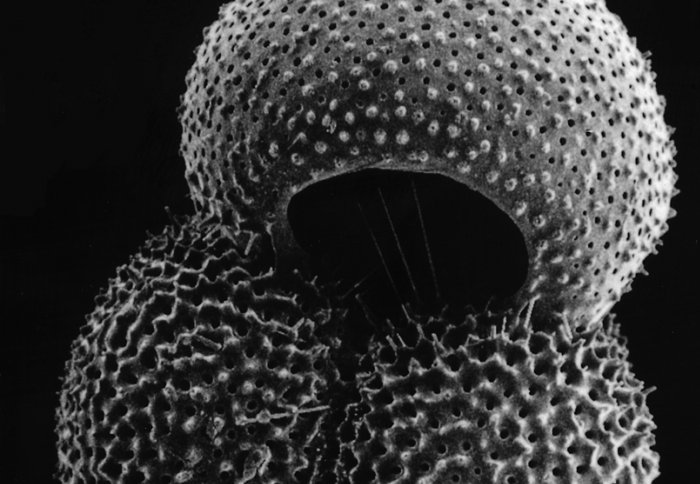Retracing footsteps of ocean plankton improves past climate reconstructions

Microscopic photo of the foraminifer Globigerinoides ruber
Insights into the travelling habits of tiny oceanic creatures are paving the way for a better understanding of past climate.
Foraminifera are plankton whose shell chemistry captures a snapshot of ocean conditions during their lifetime. When they die, they sink to the ocean floor and are eventually fossilised. Palaeoclimatologists have used fossilised foraminifera from ocean sediments deposited millions of years ago to estimate temperature, salinity and carbon dioxide levels in ancient oceans.
Our research reveals that what you find at the bottom of the ocean may have come from very far away
– Dr Erik van Sebille
Research published in Nature Communications, however, reveals that ocean currents can sweep foraminifera over thousands of kilometres, meaning they may not represent the ocean conditions of the area they were found in.
Although scientists previously suspected that ocean drift might have an impact on the data collected from core samples, this is the first time that this effect has been quantified.
“Foraminifera are at the mercy of the currents,” said lead author Dr Erik van Sebille, from the Grantham Institute at Imperial College London. “Our research reveals that what you find at the bottom of the ocean may have come from very far away.”
In other cases, depending on local currents and the species’ lifespan, foraminifera may have drifted very little, making them more accurate indicators of local conditions.
The degree of drift depends on the species of foraminifera as well as the area in which the sample was found.
“This research will help scientists improve the study of past climates because they will be able to look at a species of foraminifera and core location to very quickly get a sense of how representative their sediments are for that site,” said Dr van Sebille.
“It will give us a good indication of whether the creature we are looking at to get our past-temperature estimates was a bit of a globetrotter or a stay at home type.”
“This research allows us for the first time to grasp the margins of error caused by drift, and also it will open an entirely new dimension for the interpretation of the deep-sea climate data.” said Dr Paolo Scussolini, a contributing author and climate scientist at the VU University, Amsterdam.
By improving our understanding of our planet’s climate history, this research could help scientists to gain insight into the processes that influence climate, helping them to model future change more accurately.
Turning back time
To retrace the likely paths of foraminifera, the team used two models of ocean circulation, adding virtual particles to represent the plankton. Starting from sediment core locations, they ran the models backwards in time to pinpoint the origin of the plankton deposited in that region. By comparing the temperatures between the core location and the foraminifera’s origin, they then calculated by how much temperatures might differ.
The research team’s next mission is to revisit sediment archives to see if incorporating the effects of drift leads to better estimates of global temperature history. Eventually, they plan to build a tool that will allow researchers to estimate the likely impact of drift for any particular location.
They also intend to use a similar technique to study carbon storage in the deep ocean. As foraminifera grow, they take up carbon dioxide, locking away the carbon in their calcium carbonate shells. New insights into this process could improve our understanding of how oceans absorb carbon dioxide. “Carbon storage by dying plankton is actually a really important way in which the ocean draws down CO2 from the atmosphere,” commented Dr van Sebille.
Dr van Sebille conducted this research while at the ARC Centre of Excellence for Climate System Science at University of New South Wales in Australia, before joining the Grantham Institute last month alongside fellow Grantham lecturers Dr Kris Murray and Dr Mirabelle Muuls.
He hopes to engage colleagues at Imperial from the Earth Sciences and Engineering departments with his research on ocean drift. Apart from the pathways of plankton, he is also interested in the problem of marine plastic pollution, stressing that although plastic pollution primarily affects marine wildlife it also has an impact human livelihoods. “The more plastic there is in the ocean, the more of it ends up on our plates,” he said.
His work will include studying where plastics have the biggest impacts on marine ecosystems, as well as designing possible solutions to reduce pollution levels.
Image credit: Frank J.C. Peeters, VU University Amsterdam
Article text (excluding photos or graphics) © Imperial College London.
Photos and graphics subject to third party copyright used with permission or © Imperial College London.
Reporter
Ms Alexandra Franklin-Cheung
Centre for Environmental Policy